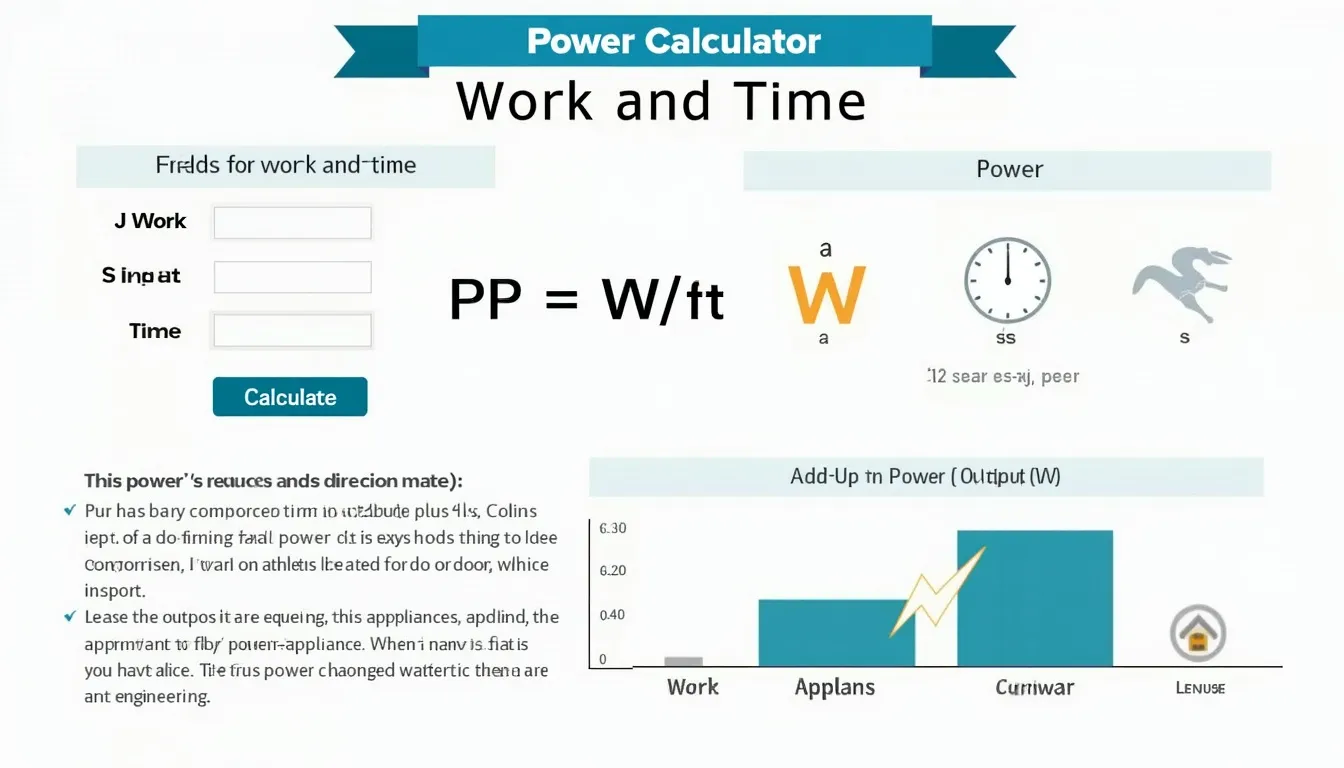Power Calculator
Is this tool helpful?
How to use the tool
- Enter work done (J): e.g., 9 500 J or 42 300 J.
- Enter time (s): e.g., 18 s or 240 s.
- Click “Calculate”: the result appears instantly in watts with two-decimal precision.
- Check validity: both inputs must be positive; the tool rejects negatives or zeros.
Formula used
Power equals work divided by time:
$$P = rac{W}{t}$$- P = power (W)
- W = work (J)
- t = time (s)
Example calculations
- Example A: 9 500 J ÷ 18 s = 527.78 W.
- Example B: 42 300 J ÷ 240 s = 176.25 W.
Quick-Facts
- The SI unit of power is the watt (W); 1 W = 1 J s⁻¹ (NIST, 2019).
- An average adult at rest outputs ≈ 100 W of metabolic power (NASA Human Integration Design Handbook, 2010).
- EU Ecodesign limits standby consumption to < 0.5 W for most devices (EU Regulation 1275/2008).
- Digital power meters reach ±0.1 % accuracy (Keysight P-Series Datasheet, 2022).
FAQ
What is power?
Power measures how fast energy changes form; one watt equals one joule each second (NIST, 2019).
Why should I use this calculator?
It eliminates manual division, reduces rounding errors, and shows results to 0.01 W for clear comparisons (Keysight Datasheet, 2022).
Which units can I enter?
Enter work in joules and time in seconds. The calculator converts only these SI units to maintain consistency (NIST, 2019).
How precise is the result?
The tool rounds to two decimals; underlying float math keeps error below 0.01 % for typical inputs (Mozilla JS Docs, 2023).
Can I convert watts to horsepower?
Yes; divide watts by 746 to obtain mechanical horsepower per SAE J1349 (SAE, 2015).
Who is the watt named after?
The unit honours James Watt, inventor of the modern steam engine (Royal Society Biography, 2021).
Do small standby loads matter?
“Even half-watt idle draws become significant when multiplied by billions of devices” (EU Commission, 2020).
How does the formula change for average power over varying loads?
Integrate instantaneous power over the interval and rac by total time: $$P_{avg}= rac{1}{t_2-t_1}\int_{t_1}^{t_2}P(t)\,dt$$ (MIT OpenCourseWare, 2018).
Important Disclaimer
The calculations, results, and content provided by our tools are not guaranteed to be accurate, complete, or reliable. Users are responsible for verifying and interpreting the results. Our content and tools may contain errors, biases, or inconsistencies. Do not enter personal data, sensitive information, or personally identifiable information in our web forms or tools. Such data entry violates our terms of service and may result in unauthorized disclosure to third parties. We reserve the right to save inputs and outputs from our tools for the purposes of error debugging, bias identification, and performance improvement. External companies providing AI models used in our tools may also save and process data in accordance with their own policies. By using our tools, you consent to this data collection and processing. We reserve the right to limit the usage of our tools based on current usability factors.







